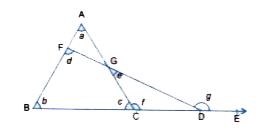If U={a,b,c,d,e,f,g,h}, find the complements of the following sets :(i) A={a,b,c} (ii) B={d,e,f,g] (iii) C={a,c,e,g} (iv) D={f,g,h,a)
nπ+(−1)nπ6,n∈Z
nπ+(−1)nπ3,n∈Z
nπ±π6,n∈Z
nπ±π3,n∈Z
The correct Answer is:A
To find the complements of the given sets with respect to the universal set U={a,b,c,d,e,f,g,h}, we will follow these steps:
1. Identify the Universal Set and the Sets:
- Universal Set U={a,b,c,d,e,f,g,h}
- Set A={a,b,c}
- Set B={d,e,f,g}
- Set C={a,c,e,g}
- Set D={f,g,h,a}
2. Find the Complement of Set A:
- The complement of set A is defined as U−A.
- Elements in A are {a,b,c}.
- Removing these from U:
U−A={d,e,f,g,h}
- Complement of A: A′={d,e,f,g,h}
3. Find the Complement of Set B:
- The complement of set B is defined as U−B.
- Elements in B are {d,e,f,g}.
- Removing these from U:
U−B={a,b,c,h}
- Complement of B: B′={a,b,c,h}
4. Find the Complement of Set C:
- The complement of set C is defined as U−C.
- Elements in C are {a,c,e,g}.
- Removing these from U:
U−C={b,d,f,h}
- Complement of C: C′={b,d,f,h}
5. Find the Complement of Set D:
- The complement of set D is defined as U−D.
- Elements in D are {f,g,h,a}.
- Removing these from U:
U−D={b,c,d,e}
- Complement of D: D′={b,c,d,e}
Summary of Complements:
- A′={d,e,f,g,h}
- B′={a,b,c,h}
- C′={b,d,f,h}
- D′={b,c,d,e}
- Universal Set U={a,b,c,d,e,f,g,h}
- Set A={a,b,c}
- Set B={d,e,f,g}
- Set C={a,c,e,g}
- Set D={f,g,h,a}
- The complement of set A is defined as U−A.
- Elements in A are {a,b,c}.
- Removing these from U:
U−A={d,e,f,g,h}
- Complement of A: A′={d,e,f,g,h}
- The complement of set B is defined as U−B.
- Elements in B are {d,e,f,g}.
- Removing these from U:
U−B={a,b,c,h}
- Complement of B: B′={a,b,c,h}
- The complement of set C is defined as U−C.
- Elements in C are {a,c,e,g}.
- Removing these from U:
U−C={b,d,f,h}
- Complement of C: C′={b,d,f,h}
- The complement of set D is defined as U−D.
- Elements in D are {f,g,h,a}.
- Removing these from U:
U−D={b,c,d,e}
- Complement of D: D′={b,c,d,e}
- A′={d,e,f,g,h}
- B′={a,b,c,h}
- C′={b,d,f,h}
- D′={b,c,d,e}
Topper's Solved these Questions
Similar Questions
Using the given diagram, express the following sets in terms of set A and B.

(i) {a,d} , (ii) {a,d,c,f}, (iii) {a,d,c,f,g,h}, (iv) {a,d,g,h}, (v) {g,h}
View SolutionLet A = { b,d,e,f }, B = { c,d,g,h} and C = {e,f,g,h} .Find :
C -A
View SolutionLet A = { b,d,e,f }, B = { c,d,g,h} and C = {e,f,g,h} .Find :
B-C
View SolutionLet U= {a,b,c,d,e,f,g} be the universal set and let its subsets be A = {a,b,d,e} and B = {b,e,g}
Verify that : (A∪B)'=(A'∩B')
View SolutionLet U= {a,b,c,d,e,f,g} be the universal set and let its subsets be A = {a,b,d,e} and B = {b,e,g}
Verify that : (A∩B)'=(A'∪B')
View SolutionLet A = { b,d,e,f }, B = { c,d,g,h} and C = {e,f,g,h} .Find :
A- B
View SolutionUse the given figure to express :
(i) a in terms of b and f,
(ii) e in terms of f and g,
(iii) d in terms of a and e,
(iv) c in terms of e and g.

View SolutionLet A = { b,d,e,f }, B = { c,d,g,h} and C = {e,f,g,h} .Find :
(B−C)∪(C−B)
View SolutionLet A = { b,d,e,f }, B = { c,d,g,h} and C = {e,f,g,h} .Find :
(A−B)∪(B−A)
View SolutionFind the area of the pentagon shown in Figure, if AD=10cm, AG=8cm, AH=6cm, AF=5cm, BF=5cm, CG=7cm and EH=3cm.
View Solution